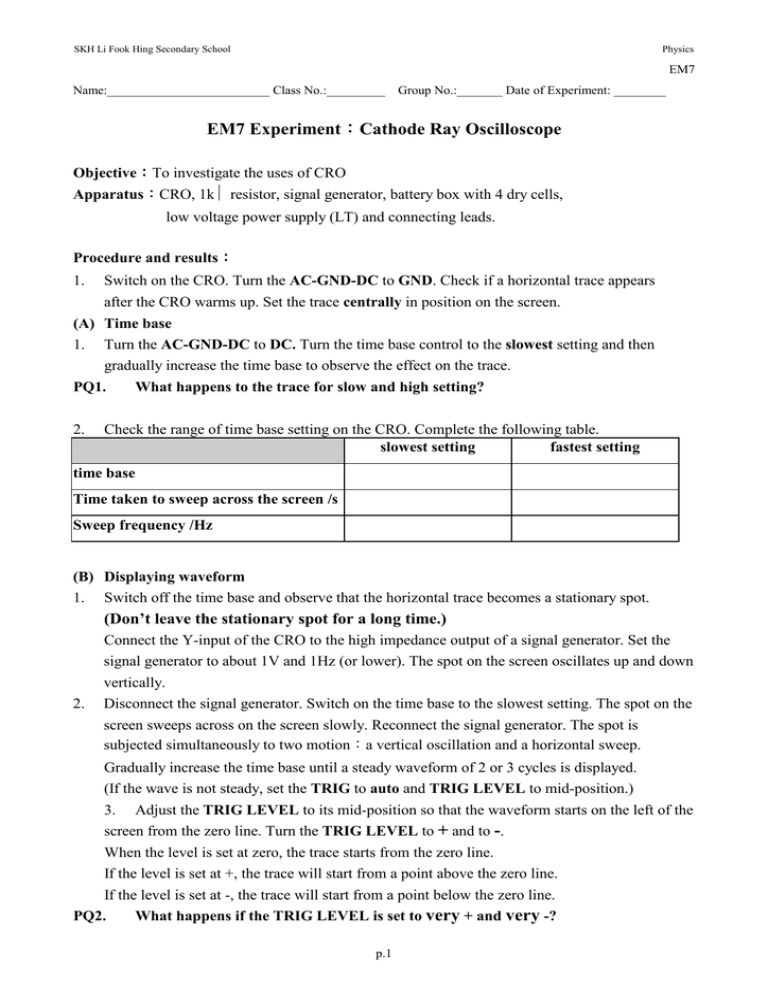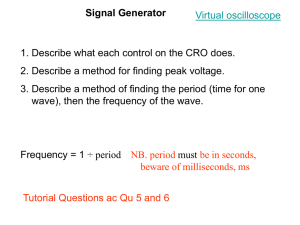Document 10277375
advertisement

SKH Li Fook Hing Secondary School Physics EM7 Name:_________________________ Class No.:_________ Group No.:_______ Date of Experiment: ________ EM7 Experiment: :Cathode Ray Oscilloscope Objective: :To investigate the uses of CRO Apparatus: :CRO, 1kΩ resistor, signal generator, battery box with 4 dry cells, low voltage power supply (LT) and connecting leads. Procedure and results: : 1. Switch on the CRO. Turn the AC-GND-DC to GND. Check if a horizontal trace appears after the CRO warms up. Set the trace centrally in position on the screen. (A) Time base 1. Turn the AC-GND-DC to DC. Turn the time base control to the slowest setting and then gradually increase the time base to observe the effect on the trace. PQ1. 2. What happens to the trace for slow and high setting? Check the range of time base setting on the CRO. Complete the following table. slowest setting fastest setting time base Time taken to sweep across the screen /s Sweep frequency /Hz (B) Displaying waveform 1. Switch off the time base and observe that the horizontal trace becomes a stationary spot. (Don’t leave the stationary spot for a long time.) Connect the Y-input of the CRO to the high impedance output of a signal generator. Set the signal generator to about 1V and 1Hz (or lower). The spot on the screen oscillates up and down vertically. 2. Disconnect the signal generator. Switch on the time base to the slowest setting. The spot on the screen sweeps across on the screen slowly. Reconnect the signal generator. The spot is subjected simultaneously to two motion:a vertical oscillation and a horizontal sweep. Gradually increase the time base until a steady waveform of 2 or 3 cycles is displayed. (If the wave is not steady, set the TRIG to auto and TRIG LEVEL to mid-position.) 3. Adjust the TRIG LEVEL to its mid-position so that the waveform starts on the left of the screen from the zero line. Turn the TRIG LEVEL to + and to -. When the level is set at zero, the trace starts from the zero line. If the level is set at +, the trace will start from a point above the zero line. If the level is set at -, the trace will start from a point below the zero line. PQ2. What happens if the TRIG LEVEL is set to very + and very -? p.1 SKH Li Fook Hing Secondary School Physics EM7 Name:_________________________ Class No.:_________ Group No.:_______ Date of Experiment: ________ (C) Measuring a.c. voltage 1. Apply about 1V, 50Hz from the signal generator to the Y-input of CRO. Adjust the time base and Y gain (The calibration knob must turn off as indicated by the control plate) so that a 2. wave of 2 or 3 cycles is displayed. The amplitude of the wave gives the peak voltage. Switch off the time base and measure the height of the vertical line. The length of the line gives the peak-to-peak voltage. Also, half the vertical line gives the peak voltage. Repeat the above steps for different input voltage and tabulate the results: (1) (2) (3) Y-gain setting Height of vertical line /cm Peak-to-peak voltage Peak voltage (D) Measuring frequency 1. Apply about 1V, 20kHz from the signal generator to the Y-input of CRO. Adjust the time base and Y gain (The calibration knob must turn off) so that a wave of 2 or 3 cycles is displayed. Measure the width of one cycle. Repeat the above steps for different input frequency and tabulate the results: (1) (2) (3) Time base setting Width of 1 cycle /cm Period T Frequency f = 1 T (E) Measuring d.c. voltage 1. Connect the battery box with one dry cell to the CRO and observe that the horizontal trace shifts up from the zero line. Measure the shift and calculate the d.c. voltage. Repeat the above steps for different number of dry cells and tabulate the results: 1 dry cell 2 dry cells 3 dry cells 4 dry cells Y-gain setting Shift d.c. voltage p.2 SKH Li Fook Hing Secondary School Physics EM7 Name:_________________________ Class No.:_________ Group No.:_______ Date of Experiment: ________ (F) Body pick-up 1. Hold the 4mm red plug of the CRO input cable in one hand. Adjust the CRO so that several cycles of a distorted waveform is displayed. Measure the voltage and frequency of the body signal. Voltage = ____________________ V PQ3. Frequency = _______________________ Hz Where does the body signal come from? (Hint: consider the frequency of the body signal.) (G) AC-GND-DC switch 1. Connect a 1kΩ resistor to the a.c. terminals of a low voltage power supply (LT). Connect the CRO input cable across the resistor. 2. Adjust the CRO so that a steady sine wave is displayed. Set the AC-GND-DC switch from DC to AC and GND in turn and observe the effect on the trace. For an a.c. input signal, the trace is not affected by switching from AC to DC or DC to AC. The trace becomes horizontal by switching to GND. 3. Set the low voltage power supply to d.c. terminal. A full-wave rectified d.c. trace is displayed on the screen. Set the AC-GND-DC switch from DC to AC and GND in turn and observe the effect on the trace. For an a.c. input signal, only the a.c. component of the a.c. is displayed by switching from 4. DC to AC (i.e. the d.c. component is blocked) Connect a dry cell to the CRO. Set the AC-GND-DC switch from DC to AC and GND in turn and observe the effect on the trace. The horizontal trace shifts from the zero line to an upper position. PQ4. What is the function of the AC-GND-DC at GND position? PQ5. What is the function of the AC-GND-DC at AC position? p.3 SKH Li Fook Hing Secondary School Physics EM7 Name:_________________________ Class No.:_________ Group No.:_______ Date of Experiment: ________ (H) Phase relationships 1. Apply about 1V 50Hz from a signal generator to the Y-input of the CRO. Switch off the time base and adjust the Y-gain so that a vertical trace of about 6cm is displayed. Disconnect the signal generator. Apply about 1V 50Hz from the low voltage power supply to the X-input. Adjust the x-gain (the red knob of the time base) so that a horizontal trace of about 6cm is displayed. 3. Apply the voltages to the X and Y inputs simultaneously and observe the pattern on the screen. 2. The pattern changes continuously through a cycle as shown. The pattern changes continuously because the two voltages have a changing phase relationship. 4. Disconnect the low voltage power supply from the x-input. Connect the signal generator to both the X and Y input. PQ6. What is seen on the screen? (I) Comparing frequency using Lissajous figures (For AL only) 1. Apply about 1V 50Hz from the signal generator to the Y-input and about 1V 50Hz from the low voltage power supply to the X-input. Gradually change the frequency of the voltage from the signal generator and observe the pattern displayed on the CRO. 2.. The patterns, called Lissajous figures, depend on the ratio of the frequencies of the two inputs. fy fx = number of loops in vertical direction number of loops in horizontal direction Some Lissajous figures, for whole number ratios, are shown below. The pattern is changing continuously if the two input signals do not have a fixed phase relationship. Reference: :Further Physics Book 2 p.307 - p.309, New Way Physics Book 3 p.210-p.217 p.4






